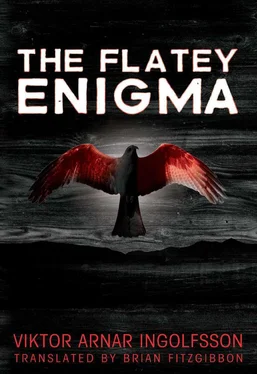Viktor Ingolfsson - The Flatey Enigma
Здесь есть возможность читать онлайн «Viktor Ingolfsson - The Flatey Enigma» весь текст электронной книги совершенно бесплатно (целиком полную версию без сокращений). В некоторых случаях можно слушать аудио, скачать через торрент в формате fb2 и присутствует краткое содержание. Жанр: Триллер, на английском языке. Описание произведения, (предисловие) а так же отзывы посетителей доступны на портале библиотеки ЛибКат.
- Название:The Flatey Enigma
- Автор:
- Жанр:
- Год:неизвестен
- ISBN:нет данных
- Рейтинг книги:5 / 5. Голосов: 1
-
Избранное:Добавить в избранное
- Отзывы:
-
Ваша оценка:
- 100
- 1
- 2
- 3
- 4
- 5
The Flatey Enigma: краткое содержание, описание и аннотация
Предлагаем к чтению аннотацию, описание, краткое содержание или предисловие (зависит от того, что написал сам автор книги «The Flatey Enigma»). Если вы не нашли необходимую информацию о книге — напишите в комментариях, мы постараемся отыскать её.
The Flatey Enigma — читать онлайн бесплатно полную книгу (весь текст) целиком
Ниже представлен текст книги, разбитый по страницам. Система сохранения места последней прочитанной страницы, позволяет с удобством читать онлайн бесплатно книгу «The Flatey Enigma», без необходимости каждый раз заново искать на чём Вы остановились. Поставьте закладку, и сможете в любой момент перейти на страницу, на которой закончили чтение.
Интервал:
Закладка:
“Mind if I ask you a few questions on the subject?”
The author took one stroke and allowed himself to float on his back again before answering. “Yes, you could certainly do that, but let me get out of the pool first, dry myself, and get dressed. I’m presuming the police will be happy to offer me a cup of coffee at the Austurbaer diner in gratitude for the information I’ll be providing? Might help to trigger off my memory, you see. Useful thing at my age, young man.”
Dagbjartur nodded, and half an hour later there were sitting at a table in the cafe on Laugavegur. They were the only customers, and Arni Sakarias asked the waitress to bring him the usual. She knew what that was and brought him a pot of coffee, a bread roll, and a Danish pastry. Dagbjartur asked for the same and the bill, which he paid.
As Arni Sakarias relished his pastry, he told Dagbjartur about the Flatey enigma.
“In the late summer of 1871, a group of Icelandic students were on a ship to Copenhagen where they were going to study over the winter. This was on the steamboat Diana, which operated as a mail boat to Iceland during those years. An excellent seafaring vessel, I’ve read, with first-and second-class cabins. This was a few years after the Flatey Book had come out in print for the first time at the expense of the Norwegian state. Gudbrandur Vigfusson and Unger took care of the publishing, although the book was printed in Oslo, and the last volume was dated 1868. This edition became popular reading material among students in Copenhagen, and there was a copy in the possession of an Icelandic scholar who was a passenger on the mail boat. The students did a lot of things to entertain themselves on the Diana during the crossing, including quizzing each other about the stories contained in the Flatey Book. There’s a whole gallery of characters that crop up in these stories, of course, and the students varied in their knowledge of them. This was their favorite pastime, though, and they decided to hold a formal quiz the following evening. A young man from the West Fjords, a budding poet and writer who also happened to be on board, was enlisted to set the quiz because he was known for his sound knowledge of ancient literature. He pored over the Oslo edition and by the following evening had completed his task. He hadn’t slept a wink all night and kept himself awake with a bottle of schnapps. He produced a list of forty questions, the last of which depended on you getting the previous thirty-nine questions right. The solution was linked to an incomplete poem, and the right answer was supposed to complete the poem. One letter contained in the answers to each question formed the solution, and the last question revealed how the letters were supposed to be arranged to form it. The writer then proposed that if a solution could not be found to the riddle on this journey, the riddle had to be kept in the Flatey Book and could not be removed from it until the solution had been found. A peculiar picture was drawn on the first page, and the legend that developed around it was that it was a magical rune that protected the writer’s instructions. The people of the West Fjords have a reputation for knowing a thing or two about magic. The students brooded over the enigma that evening and tried to piece a solution together. The questions were considered rather odd, and many of them were open to a variety of possible answers that seemed to be based more on taste than logic. But although some of the boys managed to solve some of the questions and to produce thirty-nine letters, none could solve the key to the last question that was meant to complete the poem.”
Once more Arni Sakarias became silent and for a moment stared out the window at the pedestrians on Laugavegur. Dagbjartur waited in a patient silence.
Finally, he resumed his narrative: “A tragic incident then occurred on the boat that night: the writer who had devised the enigma vanished from the ship without anyone noticing. Naturally, there was a great deal of commotion on board, and all interest in the riddle faded. There was one student, however, who held onto the papers and wrote about how the riddle was created, and then thought of taking it home to Flatey, as the poet had said. But that got delayed for some reason. The student died in Copenhagen that winter, and the sheets somehow found their way to the Royal Library. There they were placed in an archive with other material about the Flatey Book and were lost for many decades. The story of the Flatey enigma was well known, though, and was recounted in Copenhagen’s student circles from one generation to the next. In the winter of 1935, a keen Icelandic scholar was looking through some material at the Royal Library when he stumbled on the sheets. The Icelander was pushy and insisted that the author’s wishes be respected and the sheets sent to the Flatey library. It took several months to discuss this issue which, to be honest, was made in jest. Now it just so happened that they heard the Flatey library was celebrating its hundredth anniversary in 1936 and that the Munksgaard publishers were going to donate a facsimile copy of the Flatey Book, which had been published in 1930. The librarians at the Royal Library saw this as an opportunity to free themselves of the unwelcome document they considered the Flatey enigma to be, and were allowed to stick the sheets into the Munksgaard edition that was on its way to Flatey. The Icelandic scholar was then entrusted with the task of ensuring that this was all done. That smart aleck happened to be me, so I am considered to know more about this enigma than most. I can also be blamed or thanked for the fact that the sheets are now on the island. Someone at some stage wrote Aenigma Flateyensis on the sheet of riddles, which, of course, is Latin for the Flatey enigma. That was to harmonize it with the Latin title of the Munksgaard edition of the Flatey Book, which is Codex Flateyensis. The same person also had a stab at writing the last two lines of the poem, but no one has been able to verify it. So that’s the story of the enigma.”
Arni Sakarias shoved the last piece of Danish pastry into his mouth and poured himself some more coffee.
“So the enigma hasn’t been solved yet?” Dagbjartur asked.
“Not that I’ve heard.”
“Wouldn’t it be possible to solve it without going to Flatey?”
“No, impossible. The key is there and nowhere else. The questions can be found in many places, but the key, which is the rows of letters, is only to be found on the sheet that lies in the Munksgaard edition in the Flatey library. That’s where people have to go if they want to test their solutions.”
“Why hasn’t anyone just copied it?”
“It’s a matter of simple decency. The librarians in the Flatey library have taken good care of the sheets, and those who want to test their answers have to swear they won’t write the key down. There’s also a belief that anyone who breaks the rules will be cursed by a mishap. The fates of the poet and the young student in Copenhagen helped to propagate that myth. It is said that a powerful curse rests on the key to the enigma but that it won’t be unleashed so long as the sheets remain within the four walls of the library.”
“Have many people tried this?”
“No, I don’t think so. Students who are completing their studies in Icelandic philology have been known to go on pilgrimages to Flatey to have a go at it. You have to be pretty well up on the subject to be able to hazard any guesses at the answers. This isn’t a challenge for amateurs.”
“Haven’t you tried to solve the enigma yourself?”
“I just tried it once. The enigma is basically two riddles. I realized that you’ve got to solve the key to the fortieth question first. Without that, there’s no way of verifying the answers to the other thirty-nine questions. I studied that for a while but found no solution.”
Читать дальшеИнтервал:
Закладка:
Похожие книги на «The Flatey Enigma»
Представляем Вашему вниманию похожие книги на «The Flatey Enigma» списком для выбора. Мы отобрали схожую по названию и смыслу литературу в надежде предоставить читателям больше вариантов отыскать новые, интересные, ещё непрочитанные произведения.
Обсуждение, отзывы о книге «The Flatey Enigma» и просто собственные мнения читателей. Оставьте ваши комментарии, напишите, что Вы думаете о произведении, его смысле или главных героях. Укажите что конкретно понравилось, а что нет, и почему Вы так считаете.











